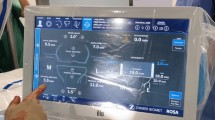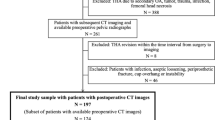Abstract
Purpose
(1) to assess the influence of medial or lateral imaging plane inclination on the measurement of sulcus angle, trochlear depth, and facet asymmetry on transverse cross-sectional images. (2) to assess the effect of measurement level (height) on these respective parameters.
Materials and methods
Twenty dry femurs (9 left, 11 right) were imaged with CT. A 3D dataset was obtained from which axial images were reconstructed in the ideal plane without inclination as well as with 8° of medial and lateral inclination. Sulcus angle, trochlear depth, and facet asymmetry were measured on the 3 image sets. In addition, the measurements were performed at 5 mm and 10 mm from the superior margin of the medial trochlear facet. Statistical analysis consisted of the Wilcoxon test and calculation of measurement variation.
Results
There were no statistically significant differences between the indicated measurements on the reference set compared to medial or lateral inclination. All measurements were significantly different depending on measurement height.
Conclusion
Medial or lateral inclination in the transverse imaging plane of 8° does not influence the values of typical parameters used for the assessment of trochlear dysplasia. The measurement height has a significant influence, and a consensus should be found as to which is the optimal measurement height.




Similar content being viewed by others
Data availability
Provided in the tables of the manuscript.
References
Chen H, Zhao D, **e J, Duan Q, Zhang J, Wu Z, Jiang J (2017) The outcomes of the modified Fulkerson osteotomy procedure to treat habitual patellar dislocation associated with high-grade trochlear dysplasia. BMC Musculoskelet 18:73. https://doi.org/10.1186/s12891-017-1417-4
DeJour D, Saggin, (2010) The sulcus deepening trochleoplasty—the Lyon’s procedure. Int Orthop 34:311–316. https://doi.org/10.1007/s00264-009-0933-8
Dietrich T, Fucentese S, Pfirrmann C (2016) Imaging of individual anatomical risk factors for patellar instability. Semin Musculoskelet Radiol 20:65–73. https://doi.org/10.1055/s-0036-1579675
Duthon VB (2015) Acute traumatic patellar dislocation. Orthop Traumatol-Sur 101:S59-67. https://doi.org/10.1016/j.otsr.2014.12.001
Ferlic PW, Runer A, Dammerer D, Wansch J, Hackl W, Liebensteiner MC (2018) Patella height correlates with trochlear dysplasia a computed tomography image analysis. Arthrosc 34:1921–1928. https://doi.org/10.1016/j.arthro.2018.01.051
Jamali AA, Meehan JP, Moroski NM, Anderson MJ, Lamba R, Parise C (2017) Do small changes in rotation affect measurements of lower extremity limb alignment? J Orthop Res 12:77. https://doi.org/10.1186/s13018-017-0571-6
Koëter S, Bongers EMHF, de Rooij J, van Kampen A (2006) Minimal rotation aberrations cause radiographic misdiagnosis of trochlear dysplasia. Knee Surg Sports Traumatol Arthrosc 14:713–717. https://doi.org/10.1007/s00167-005-0031-4
Kyung HS, Kim HJ (2015) Patellofemoral ligament reconstruction: a comprehensive review. Knee surg relat res 27:133–140. https://doi.org/10.5792/ksrr.2015.27.3.133
Lippacher S, Dejour D, Elsharkawi M, Dornacher D, Ring C, Dreyhaupt J, Reichel H, Nelitz M (2012) Observer agreement on the dejour trochlear dysplasia classification: a comparison of true lateral radiographs and axial magnetic resonance images. Am J Sports Med 40:837–843. https://doi.org/10.1177/0363546511433028
Nelitz M, Lippacher S, Reichel H, Dornacher D (2014) Evaluation of trochlear dysplasia using MRI: correlation between the classification system of Dejour and objective parameters of trochlear dysplasia. Knee Surg Sports Traumatol Arthrosc 22:120–127. https://doi.org/10.1007/s00167-012-2321-y
Paiva M, Blønd L, Hölmich P, Steensen RN, Diederichs G, Feller JA, Barfod KW (2018) Quality assessment of radiological measurements of trochlear dysplasia; a literature review. Knee Surg Sports Traumatol Arthrosc 22:120–127. https://doi.org/10.1007/s00167-017-4520-z
Parikh SN, Lykissas MG, Gkiatas I (2018) Predicting risk of recurrent patellar dislocation. Curr Rev Musculoskelet. https://doi.org/10.1007/s12178-018-9480-5
Steensen RN, Bentley JC, Trinh TQ, Backes JR, Wiltfong RE (2015) The prevalence and combined prevalences of anatomic factors associated with recurrent patellar dislocation: a magnetic resonance imaging study. Am J Sports Med 43:921–927. https://doi.org/10.1177/0363546514563904
Voss A, Shin SR, Murakami AM, Cote MP, Achtnich A, Herbst E, Schepsis AA, Edgar C (2017) Objective quantification of trochlear dysplasia: assessment of the difference in morphology between control and chronic patellofemoral instability patients. Knee 24:1247–1255. https://doi.org/10.1016/j.knee.2017.05.024
Funding
No funding.
Author information
Authors and Affiliations
Contributions
KV data collection, first manuscript, literature, SD manuscript revision, NB statistics, manuscript revision, JV anatomical study, analysis, Sofie Germonpré: study design, SP anatomical study, manuscript revision, ADS anatomical research, MDM study design, data analysis, final manuscript.
Corresponding author
Ethics declarations
Conflict of interest
No competing interest to disclose.
Ethics approval and consent to participate
Ethical board approval and written consent were obtained.
Consent for publication
Approved by test subjects and authors.
Additional information
Publisher's Note
Springer Nature remains neutral with regard to jurisdictional claims in published maps and institutional affiliations.
Rights and permissions
Springer Nature or its licensor (e.g. a society or other partner) holds exclusive rights to this article under a publishing agreement with the author(s) or other rightsholder(s); author self-archiving of the accepted manuscript version of this article is solely governed by the terms of such publishing agreement and applicable law.
About this article
Cite this article
Vranken, K., Doring, S., Buls, N. et al. Influence of medial and lateral imaging plane inclination on assessment of trochlear depth, sulcus angle, and facet asymmetry in the setting of trochlear anatomy: a cadaveric study. Surg Radiol Anat 45, 207–213 (2023). https://doi.org/10.1007/s00276-022-03069-5
Received:
Accepted:
Published:
Issue Date:
DOI: https://doi.org/10.1007/s00276-022-03069-5




